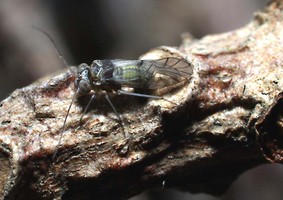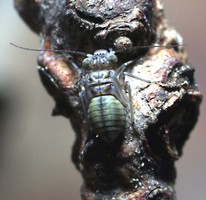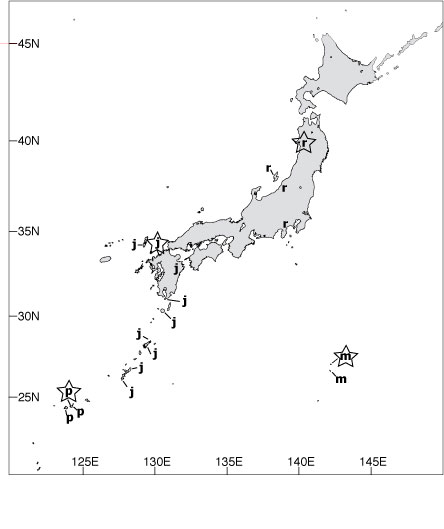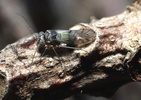Ptycta johnsoni
Emilie BessIntroduction
Ptycta johnsoni is one of four species of Ptycta from Japan. This species lives in subtropical regions (see distribution map) and inhabits trees at the edge of forests and in populated areas.
Characteristics
Ptycta johnsoni can be distinguished by:
- Forewing with wide basal band and nodal band, pigmentation on anterior margin and apical 1/3 of pterostigma.
- Male genitalia: Basal paraproct lobe short in anterodorsal orientation, posterior lobe of paraproct rounded, dorsal corners of hypandrium reduced; phallosome long with narrow basal margin.
- Female genitalia: Sclerite of subgenital plate with broad triangular anterior margin. Distributed from Okinawajima Island to Tsushima Island.


Forewing of Ptycta johnsoni. Cubital loop and areola postica joined to M is typical of the family Psocidae. The fusion of veins Rs & M distinguishes the genus Ptycta from the sister genus Copostigma.
References
Badonnel A (1967) Insectes Psocoptères. Faune de Madagascar 23: 1-238.
Bess, E. C. and K. Yoshizawa. Redefinition of Ptycta Enderlein (Psocodea: 'Psocoptera': Psocidae) and a Taxonomic Revision of the Japanese Species. Submitted to Entomological Science.
Chui VWD, Thornton IWB (1972) A numerical taxonomic study of the endemic Ptycta species of the Hawaiian Islands (Psocoptera: Psocidae). Systematic Zoology 21: 7-22.
Endang SK, Thornton IWB, New TR (2002) The Psocidae (Insecta : Psocoptera) of Java and the eastern islands of Indonesia. Invertebrate Systematics 16: 107-176.
Enderlein G (1903) Die Copeognathen des indo_australischen Faunengebietes. Annales historico-naturales Musei nationalis Hungarici 1: 179-344.
Enderlein G (1906) Die australischen Copeognathen. Zoologische Jahrbücher (Abteilung Systematik) 23: 401-412.
Enderlein G (1925) Beiträge zur Kenntnis der Copeognathen IX. Konowia 4: 97-108.
Enderlein G (1931) The Percy Sladen Trust Expedition to the Indian Ocean in 1905, under the leadership of Mr J. Stanley Gardiner, M.A. VIII. Die Copeognathen-Fauna der Seychellen. Transactions of the Linnean Society of London, 2nd Series, Zoology 19: 207-240.
Günther KK (1974) Staubläuse, Psocoptera. In: Die Tierwelt Deutschlands. Jena. 61. Teil.
Lienhard C, Smithers CN (2002) Psocoptera (Insecta) World Catalogue and Bibliography. Muséum d'Histoire Naturelle, Geneva, Switzerland.
Mockford EL (1993) North American Psocoptera (Insecta). Sandhill Crane Press, Gainesville, Florida.
Mockford EL (2001) Additions and corrections to "A classification of the psocopteran family Caeciliusidae (Caeciliidae auct.)". Transactions of the American Entomological Society 127: 79-84.
Okamoto H (1907) Die Psociden Japans. Transactions of the Sapporo Natural History Society 2: 113-147.
Pearman JV (1934) New and little known African Psocoptera. Stylops 3: 121-132.
Perkins RCL (1899) Neuroptera. In: Fauna Hawaiiensis, pp. 77-87. Cambridge University Press, Cambridge.
Smithers CN (1972) The classification and phylogeny of the Psocoptera. Australian Museum Memoirs 14: 1-349.
Smithers CN (1983) A reappraisal of Clematostigma Enderlein with notes on related genera (Psocoptera: Psocidae). Australian Entomological Magazine 9: 71-79
Smithers CN (1985) Redefinition of Copostigma Enderlein (Psocoptera: Psocidae). Australian Entomological Magazine 12: 61-62.
Smithers CN, Thornton IWB (1990) Systematics and distribution of the Melanesian Psocidae (Psocoptera). Invertebrate Taxonomy 3: 431-468.
Thornton IWB (1981) Psocoptera of the Fiji Islands. Pacific Insects Monographs 37: 1-105.
Thornton IWB (1984) Psocoptera of the Hawaiian Islands. Part III. The endemic Ptycta complex (Psocidae): systematics, distribution and evolution. International Journal of Entomology 26: 1-128.
Thornton IWB, Lee SS, Chui VWD (1972) Insects of Micronesia: Psocoptera. Insects of Micronesia 8: 45-144.
Yoshizawa K (2002) Phylogeny and higher classification of suborder Psocomorpha (Insecta: Psocodea:'Psocoptera'). Zoological Journal of the Linnean Society 136: 371-400.
Yoshizawa K (2005) Morphology of Psocomorpha (Psocodea:'Psocoptera'). Insecta Matsumurana 62: 1-44.
Yoshizawa K, Smithers CN (in press) Systematic position of Trichodenotecnum enderleini (Roesler) (Psocodea: 'Psocoptera': Psocodae). Records of the Australian Museum.
Title Illustrations

| Scientific Name | Ptycta johnsoni |
|---|---|
| Location | Nokonoshima Island, Kyushu, Japan |
| Specimen Condition | Live Specimen |
| Sex | Male |
| Life Cycle Stage | adult |
| View | dorsal |
| Size | 4mm |
| Copyright | © 2006 Kazunori Yoshizawa |
| Scientific Name | Ptycta johnsoni |
|---|---|
| Location | Nokonoshima Island, Kyushu, Japan |
| Specimen Condition | Live Specimen |
| Life Cycle Stage | nymph (immature) |
| View | dorsal |
| Size | 3mm |
| Copyright | © 2006 Kazunori Yoshizawa |
About This Page
Emilie Bess

Illinois Natural History Survey, Champaign, Illinois, USA
Correspondence regarding this page should be directed to Emilie Bess at
Page copyright © 2009 Emilie Bess
All Rights Reserved.
- First online 11 October 2006
- Content changed 25 March 2009
Citing this page:
Bess, Emilie. 2009. Ptycta johnsoni . Version 25 March 2009 (under construction). http://tolweb.org/Ptycta_johnsoni/68935/2009.03.25 in The Tree of Life Web Project, http://tolweb.org/











 Go to quick links
Go to quick search
Go to navigation for this section of the ToL site
Go to detailed links for the ToL site
Go to quick links
Go to quick search
Go to navigation for this section of the ToL site
Go to detailed links for the ToL site